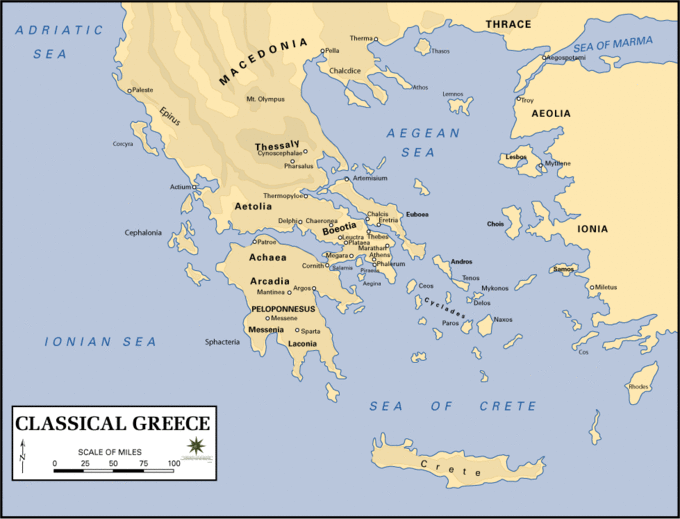Ancient Greek Culture
Ancient Greek culture covers over a thousand years of history, from the earliest civilizations in the area to the cultures that became the Ancient Greeks. Following a Greek Dark Age, Greece once more flourished and developed into the ancient culture that we recognize today .

Ancient Greece
Map of Ancient Greece
Greek culture is based on a series of shared values that connected independent city-states throughout the region, which expanded as far north as Mount Olympus. Greek society was insular, and loyalties were focused around one's polis (city-state). Greeks considered themselves civilized and considered outsiders as barbaric. While Greek daily life and loyalty was centered on one's polis, the Greeks did create leagues, which vied for control of the peninsula, and were able to unite together against a common threat (such as the Persians).
Greek culture is focused on their government, art, architecture, philosophy, and sport. Athens was intensely proud of its creation of democracy, and citizens from all poleis (city-states) took part in civic duties. Cities commissioned artists and architects to honor their gods and beautify their cities. Greek philosophers, mathematicians, and thinkers are still honored in society today. As a religious people, the Greeks worshipped a number of gods through sacrifice, ritual, and festival.
Bronze Age and Proto-Greek Civilizations
During the Bronze Age, several distinct cultures developed around the Aegean. The Cycladic civilization, around the Cyclades Islands, thrived from 3,000 to 2,000 BCE. Little is known about the Cycladic civilization because they left no written records. Their material culture is mainly excavated from grave sites, which reveal that the people produced unique, geometric marble figures.
The Minoan civilization stretches from 3700 BCE until 1200 BCE, and thrived during their Neopalatial period (from 1700 to 1400 BCE), with the large-scale building of communal "palaces. " Numerous archives have been discovered at Minoan sites; however their language, Linear A, has yet to be deciphered. The culture was centered on trade and production, and the Minoans were great seafarers on the Mediterranean Sea.
A proto-Greek culture known as the Mycenaeans developed and flourished on the mainland, eventually conquering the Aegean Islands and Crete, where the Minoan civilization was centered. The Mycenaeans developed a fractioned, war-like culture that was centered on the authority of a single ruler. Their culture eventually collapsed, but many of their citadel sites were occupied through the Greek Dark Age and rebuilt into Greek city-states.
The Dark Age
From around 1200 BCE, the palace centers and outlying settlements of the Mycenaeans' culture began to be abandoned or destroyed. By 1050 BCE, the recognizable features of Mycenaean culture had disappeared. Many explanations attribute the fall of the Mycenaean civilization and the Bronze Age collapse to climatic or environmental catastrophe, combined with an invasion by Dorians or by the Sea Peoples, or to the widespread availability of edged weapons of iron, but no single explanation fits the available archaeological evidence. This two- to three-century span of history is also known as the Homeric Age. It is believed that the Homeric epics The Iliad and The Odyssey were first recited around this time.
The Geometric and Orientalizing periods
The Geometric period (c. 900-700 BCE), which derives its name from the proliferation of geometric designs and rendering of figures in art, witnessed the emergence of a new culture on the Greek mainland. The culture's change in language, adaptation of the Phoenician alphabet, and new funerary practices and material culture suggest the ethnic population changed from the mainland's previous inhabitants, the Mycenaeans. During this time, the new culture was centered on the people and independent poleis, which divided the land into regional populations. This period witnessed a growth in population and the revival of trade.
The Orientalizing period (c. 700-600 BCE) is named for the cultural exchanges the Greeks had with Eastern, or "Oriental" civilizations. During this time, international trade began to flourish. Art from this period reflects contact with locations such as Egypt, Syria, Assyria, Phoenicia, and Israel.
Archaic Greece
Greece's Archaic period lasted from 600 to 480 BCE, in which the Greek culture expanded. The population in Greece began to rise and the Greeks began to colonize along the coasts of the Mediterranean and the Black Sea. The poleis at this time were typically ruled by a single ruler who commanded the city by force. For the city of Athens, this led to the creation of democracy. Several city-states emerged as major powers, including Athens, Sparta, Corinth, and Thebes. These poleis were often warring with each other, and formed coalitions to gain power and allies. The Persian invasion of Greece in 480 BCE marked the end of the Archaic period.
Classical Greece
The era of Classical Greece began in 480 BCE with the sacking of Athens by the Persians. The Persian invasion of Greece, first lead by Darius I and then by his son Xerxes, united Greece against a common enemy. With the defeat of the Persian threat, Athens became the most powerful polis until the start of the Peloponnesian War in 431 BCE. These wars continued on and off until 400 BCE. While marred by war, the Classical period saw the height of Greek culture and the creation of some of Greece's most famous art and architecture. However, peace and stability in Greece was not achieved until it was conquered and united by Macedonia under the leadership of Philip II and Alexander the Great in the mid-third century BCE.
Hellenistic Greece
The Hellenistic period began with the death of Alexander the Great in 323 BCE, and ended with the Roman victory at the Battle of Actium in 30 BCE. Greece poleis spent this time under the hegemony of foreign rulers, first the Macedons and then the Romans, starting in 146 BCE. New centers of Hellenic culture flourished through Greece and on foreign soil, including the cities of Pergamon, Antioch, and Alexandria, the capitals of the post-Alexander the Great empires of the Attalids, Seleucids, and Ptolemies.